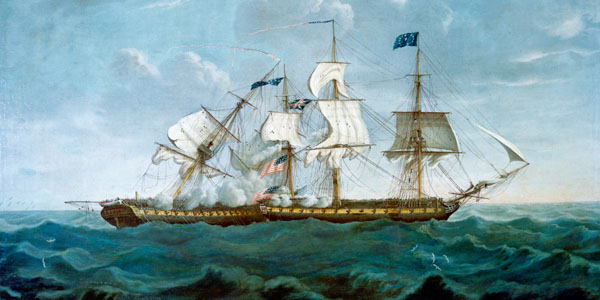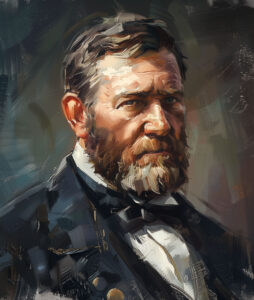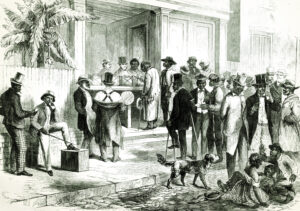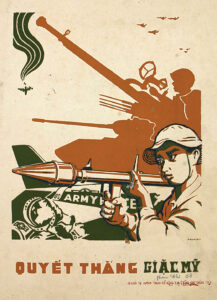
On the first day of August 1812, a damp and foggy Saturday morning in Boston, the American frigate Constitution awaited only a fair wind to proceed to sea. Its captain, Isaac Hull, had spent the week supplying his ship and growing anxious over the absence of orders from Washington. Rumors were swirling over the whereabouts of the powerful British squadron that had chased and almost captured the Constitution off the coast of New Jersey two weeks earlier; one report even placed two British frigates in Massachusetts Bay itself, where they would be in a position to seal Boston Harbor shut. Hull had sent to New York, where Secretary of the Navy Paul Hamilton originally had ordered him, for any letters that might have been directed to him there. But apparently neither Hamilton nor his squadron’s commander, Captain John Rodgers, had left him instructions. On July 28, Hull wrote Hamilton explaining his haste to get to sea while there was still a chance, and hoping again that he was not exceeding his authority: “Should I proceed to Sea without your further orders, and it should not meet your approbation, I shall be very unhappy, for I pray you to be assured in doing so I shall act as at this moment I believe you would order me to do.”
With the Constitution‘s surprising victory over the British frigate Guerrière just as the War of 1812 opened, the United States loudly trumpeted its arrival as a sea power
Hull was the son of a Connecticut merchant captain, and like many American naval officers had begun his career in that trade too. But he was an unusual commander even by the standards of the unformed American navy. His novel approach to being the captain of a ship of war was to take unfeigned delight in the job. He was short and pudgy and by outward appearances far from a commanding personality. When Gilbert Stuart was commissioned to paint his portrait, Stuart remarked to another artist who had previously painted him, “He always looks as if he was looking at the sun and half shutting his eyes.”
Hull made a point of avoiding personal confrontations and never fought a duel; he disliked corporal punishment and rarely ordered men flogged; he wrote his fellow captain William Bainbridge humorous letters about his tribulations in love as a 38-year-old bachelor, and about how much he wished he had money.
But to the officers and men who knew him, there was no mistaking his bravery, or his seamanship. In the Quasi War against France, he had led a daring cutting-out expedition that boarded and seized a French privateer in the Caribbean. In the Tripolitan War, as Captain Hugh G. Campbell’s lieutenant on the frigate Adams, he had saved the ship from disaster with his quick thinking and decisive action. Campbell was not known as much of a seaman, and when the ship began drifting rapidly toward the rocks in Algeciras harbor near Gibraltar, the captain was momentarily struck speechless. Hull, running on deck wearing only his nightshirt and carrying a pair of striped pantaloons, grabbed the speaking trumpet out of Campbell’s hands, issued a quick series of orders to get the ship out of danger, and—seeing the furious astonishment on Campbell’s face—turned to the captain and said, “Keep yourself cool, Sir, and the ship will be got off.” And then he had calmly pulled on his pantaloons. The crew kept a straight face but a new catch phrase was soon heard throughout the ship: “Keep yourself cool!”
Hull’s letter from Boston to Secretary Hamilton crossed in the mail with one from Washington written the same date. “On the arrival of the Constitution in port, I have ordered Commodore Bainbridge to take command of her,” the secretary instructed Hull. “You will accordingly deliver up to him the command and proceed to this place.” Whether Hull had an inkling of what was in the wind or not—and given Bainbridge’s seniority, his presence in Boston, and his repeated demands for the command of the Constitution or another one of the tiny American navy’s three large frigates, it was unlikely Hull did not—he weighed anchor on Sunday, August 2. He wrote a final hasty note to Hamilton, saying that “to remain here any time longer I am confident that the Ship would be blockaded in by a Superiour force, and probably would not get out for months.”
The harbor was filled with small vessels, 50 sailing ships in view as they stood out from the lighthouse a little past 6 in the morning. By afternoon the land was lost to sight.
For two weeks Hull saw scarcely another sail. On August 15 the Constitution scattered a group of ships eastward in a long chase beginning at sunrise that carried it within 40 miles of Cape Race, Newfoundland. A British sloop of war ran free, but in midafternoon the Constitution caught up with an American brig that had been taken as a prize by the sloop, with a British master’s mate and five seamen aboard.
The prisoners told Hull that the British squadron was just to the east, on the edge of the Grand Banks of Newfoundland: unbeknownst to Hull, the squadron had left the area weeks before to escort a homebound West India merchant convoy and only a few days earlier had turned back for New York.
On August 18 the Constitution encountered an American privateer whose crew told Hull they had seen a large ship of war, standing alone, to the south not far from them. Hoping to meet the enemy on equal terms, and anxious to avoid running into the whole squadron, Hull decided to change his course southward at the first opportunity.
The lone frigate was the Guerrière, commanded by Captain James R. Dacres. It had gone with the squadron halfway across the Atlantic but then been detached and ordered to Halifax to replenish stores and refit. On the way in to Halifax, the Guerrière had already encountered and captured several American merchant ships—better luck than the rest of the squadron had in its weeks of blue-water sailing. On August 10 an American merchant brig, the Betsey, bound for Boston from Naples, Italy, with a load of brandy, had fallen in with the Guerrière on the Western Banks of Newfoundland. The Betsey’s master, William B. Orne, was taken aboard as a prisoner and his ship sent on to Halifax as a prize. The day after taking the Betsey, the Guerrière halted and boarded the merchant brig John Adams, bound for New York. Finding that the ship was sailing under a British license, Dacres told the brig’s captain he could go on his way, but not before he wrote an entry into the ship’s register: “Capt. Dacres, commander of his Britannic Majesty’s frigate Guerrière, of forty-four guns, presents his compliments to commodore Rodgers, of the United States frigate President, and will be very happy to meet him, or any other American frigate of equal force to the President, off Sandy Hook, for the purpose of having a few minutes tête-à-tête.”
At 2 o’clock on the afternoon of August 19, the Constitution spotted a sail in the far distance off the port bow. Hull was on deck instantly, followed quickly by nearly every man on board. “Before all the hands could be called, there was a general rush on deck,” said Able Seaman Moses Smith. “The word had passed like lightning from man to man; and all who could be spared came flocking up like pigeons from a net bed. From the spar deck to the gun deck, from that to the berth deck, every man was roused and on his feet. All eyes were turned in the direction of the strange sail, and quick as thought studding-sails were out, fore and aft.”
The Guerrière spotted the American ship almost simultaneously. On deck Dacres handed Orne his glass and asked if it was an American or French frigate. Orne said he thought American for sure, but Dacres replied that it “acted most too bold to be an American.” Dacres paused, then added, “The better he behaves, the more honor we shall gain by taking him,” even remarking to Orne that he would “be made for life” as the first British captain to capture an American frigate. The British crew facetiously hung a barrel of molasses in the netting for their prisoners-to-be: Yankees were said to like a drink of molasses and water known as switchel. Dacres allowed 10 impressed Americans in the crew to go below, and turning politely to Orne, the captain asked if he would like to go below as well and help the surgeon tend to any wounded from the battle—“as I suppose you do not wish to fight against your own countrymen.”
Just before he left the deck, Orne saw the main topsail backed—the yard rotated around so the sail caught the wind and checked the ship’s forward motion—as the Guerrière stood by to let the rapidly approaching American come down. A British ensign flew forth from each masthead, and the drum began to roll to bring the men to quarters.
Since the Constitution was to windward, it held several theoretical advantages in a ship-on-ship engagement. A ship to leeward, heeling away from the wind, exposed a portion of its hull below the waterline to the enemy’s shot; in a close action the smoke from a windward ship’s guns might envelop an opponent, obscuring the aim of its gun crews; the sails of the ship on the windward side could block the wind and becalm the leeward ship, hindering its maneuverability. But most of all, the commander of the ship to windward held the power of decision; he could haul away and avoid a fight, and an equal opponent to leeward could never intercept and catch him, or he could use the wind to steer a direct course to come up as quickly as possible to close with the enemy.
That posed its own risks: The more direct the angle of approach the more exposed the approaching ship was to the enemy’s broadside, while unable to answer with its own. But that was the course Hull chose. As the American came up, Dacres several times changed his course to fire broadsides. The first fell short, and others went too high, and each time Hull ordered his ship to yaw slightly to take the enemy fire on the side of the bows and avoid being raked down the vulnerable length of the deck. Ships usually went into battle with only topsails to avoid the danger of sails catching fire from their own cannons’ flaming wads and to keep to a minimum the number of sail trimmers needed, but Hull ordered more sail in order to close rapidly and bring his ship right alongside the enemy. The crew broke out with three cheers.
With the Constitution coming up on the Guerrière’s windward quarter, the sternmost guns on the British ship now began to bear and some of its shots started to tell. Several men on the Constitution were mowed down, and Lieutenant Charles Morris impatiently asked the captain for permission to fire.
“No, sir,” Hull replied. A dead silence hung over the ship. “No firing at random!” Hull shouted. “Let every man look well to his aim.” At 6:05 p.m. the Constitution was directly alongside, two dozen yards away, less than the reach of a pistol shot. Then came the first crashing broadside from every gun on the Constitution’s starboard side, double-shotted and fired right into the deck and gun ports of the enemy.
Orne, crouching in the cramped cockpit below the Guerrière’s waterline, heard “a tremendous explosion…the effect of her shot seemed to make the Guerrière reel, and tremble as though she had received the shock of an earthquake.” Almost instantly came an even more tremendous crash. And then, as the smoke from the last shot cleared, the men on the Constitution were cheering like maniacs: The Guerrière’s mizzenmast had gone by the board.
“Huzzah boys! We’ve made a brig of her!” one of the Constitution’s crew shouted. “Next time we’ll make her a sloop!” said another. Hull, who had literally split his dress breeches when he excitedly leapt atop an arms chest for a better view, exclaimed, “By God, that vessel is ours.” The cockpit of the Guerrière was instantly filled with wounded and dying men, barely leaving room for the surgeons to work at the long table in the center that they knelt or bent over. From the decks above, Orne said, blood poured down as if a washtub full had been turned over.
Most of the Constitution’s sails and spars were still undamaged, and it began to forge ahead. Hull ordered the ship brought to starboard to cross the Guerrière’s bow. The British ship attempted to turn in parallel to foil the maneuver, but the drag of its fallen mizzenmast in the water prevented it from answering its helm, and the Constitution began to pour a murderous fire, two full broadsides, into the enemy’s port bow. Grape shot—clusters of balls weighing a couple of pounds apiece that separated like a shotgun’s blast when fired—swept across the decks and mowed men down while round shot continued to take a toll on the Guerrière’s masts.
To keep the Guerrière from passing across its stern and raking the Constitution in turn, the American ship bore up, but the Guerrière’s bowsprit and jib boom crossed its quarterdeck and became entangled in the mizzen rigging. Men crowded on the forecastle of the Guerrière preparing to board or repel boarders, and Lieutenant Morris quickly suggested to Hull that he call the Constitution’s boarders too, and then joined the men running for the ship’s stern preparing to board the enemy. As Morris began to wrap a few turns of a stout line over the enemy’s bowsprit to hold the ship fast, a musket ball tore into his abdomen, knocking him to the deck, grievously wounded. Lieutenant William S. Bush, the captain of the Constitution’s marines, leapt on the taffrail at almost the same moment, sword in hand, shouting, “Shall I board her?” when he was drilled through the cheek by a musket ball that tore through the back of his head, shattering his skull and killing him instantly. The barrel of molasses hanging over the Guerrière was riddled with holes, and molasses poured over the deck. During the closest part of the battle, the Constitution’s gunners fired a hundred rounds of canister shot—cylinders packed with bullets, nails, bolts, scraps of old iron—which were even more deadly than grapeshot at short range.
Although only a few of the Guerrière’s forwardmost guns would bear, the British sailors ran one of the guns almost into the window of the captain’s cabin on the Constitution and a flaming wad came aboard, starting a fire, but the Americans quickly put it out. Marines in the Constitution’s mizzentop kept up a steady barrage of musketry, shooting down over the head-high breastwork of hammocks packed into the netting over both ships’ rails, clearing the forecastle of the enemy and wounding Dacres in the back as he stood on the piled hammocks. Hull was about to climb back onto the arms chest when a sailor grabbed him by the arm. “Don’t get up there, sir, unless you take them swabs off!” the sailor said, pointing to Hull’s epaulets, which made him a prime target for sharpshooters.
Boarding would still have been extremely dicey at this point, the boarders having to make their way single file over the bowsprit of the Guerrière in a heavy running sea. But in rapid sequence the ships tore away, the foremast of the British ship fell in a cascade of spars and rigging over its starboard side, and then the mainmast went too. Not a spar was left standing on the Guerrière but the bowsprit. Hull immediately ordered his sails filled and hauled off.
For half an hour the Constitution stood off nearby as its rigging was repaired. The sun had gone down and it was hard to see if any of the enemy’s colors were still flying, though the guns had fallen silent. Orne made his way up onto the Guerrière’s deck. The scene was “a perfect hell,” he said. Blood was everywhere, like a slaughterhouse. Men were throwing the dead overboard, but many of the petty officers and crewmen had broken into the spirit locker and were screaming drunk. The mastless ship, with nothing but a jury-rigged scrap of canvas flying from the bowsprit, lay “rolling like a log in the trough of the sea,” its main deck guns under water. Water poured in from 30 holes smashed through its side below the waterline. A British ensign was still flying from the stump of the mizzenmast, but with a crack the spritsail yard carried away, taking with it any hope of bringing the ship before the wind and fighting on.
The American ship now wore back and stood across the Guerrière’s bow, completing the picture of helplessness. From the Constitution a boat rowed over under a flag of truce and Lieutenant George Read hailed the ship: “I wish to see the officer in command.” Dacres stood on the deck appearing slightly dazed. Read hailed again: “Commodore Hull’s compliments, and wishes to know if you have struck your flag.”
The British officers had already held a council and agreed that further resistance was futile, but Dacres seemed unable to utter the fateful words. “Well, I don’t know,” he finally said, “our mizzen-mast is gone, our main-mast is gone—and upon the whole, you may say we have struck our flag.” Read asked if the Americans could send their surgeon to lend assistance. “Well, I should suppose you had on board your own ship business enough for all your medical officers,” Dacres replied.
“Oh, no,” said Read, “we have only seven wounded, and they were dressed half an hour ago.” Dacres then turned to Orne and said, “How our situations have suddenly been reversed: You are now free and I am a prisoner.”
The British captain came across in the boat to present his sword to Hull and formally surrender. “Your men are a set of tigers,” he said to Hull in wonderment. Not a single shot had hulled the Constitution; casualties were seven dead, seven wounded. The British ship officially reported 15 dead and 62 wounded but Orne was certain that at least 25 more crewmen were dead, their bodies dumped over the side, or swept to their deaths with the falling of the masts. The American victory had taken 25 minutes, and the accuracy of American fire had been decisive. Hull would later single out for praise his black sailors: “I never had any better fighters…they stripped to the waist, and fought like devils, seemingly insensible to danger, and to be possessed with a determination to outfight the white sailors.”
All night, the Constitution’s boats went back and forth removing the prisoners. By dawn the condition of the Guerrière was clearly hopeless; Hull declared the ship “a perfect Wreck,” and he hastened to get the remaining wounded men off before it sank. Six feet of planking had been completely shot away in one place below the waterline, there was five feet of water in the hold, and the pumps could not keep up. At 3 o’clock in the afternoon the two captains watched in silence from the Constitution’s quarterdeck as Lieutenant Read’s boat began to row back for the last time, and minutes later the British frigate was ablaze from the scuttling charge Read had set, its guns discharging in succession as the heat of the flame reached them; then, even before Read could get aboard, there was a momentary silence followed by a deafening roar. It was like waiting for a volcano to erupt, Moses Smith remembered; the quarterdeck, immediately over the magazine, heaved skyward in a single piece and broke into fragments, and the Guerrière’s whole hull parted in two. Seconds later the entire ship disappeared beneath the sea’s surface.
Upon their return to Boston at the end of August, Hull and his crew were hailed across the nation as heroes for having secured America’s first naval victory over the mighty British. The people of Boston threw the officers a banquet, and Congress awarded the officers and crew $50,000. The Constitution earned the nickname “Old Ironsides,” thanks to sailors who told of British cannonballs bouncing off its hull during the battle.
Word awaited Hull that his brother, who ran the family’s business, had died while the Constitution had been at sea. Citing pressing matters, he turned over command to Commodore Bainbridge. He ended the war in charge of the naval yard in Portsmouth, New Hampshire.
Dacres, after a brief stint as a prisoner of war—and a perfunctory court-martial in Halifax, at which he was acquitted and found blameless for the loss of his ship—returned to duty in the Royal Navy with the largely uneventful command of another frigate for the duration of the war.
A century after the war’s end, Henry Adams—grandson and great-grandson of American presidents and one of the nation’s first truly professional historians—wrote a brilliant, skeptical, and often wickedly humorous history of James Madison’s administration that cast the War of 1812 as a largely indecisive conflict that accomplished none of its stated aims and seemed more the product of Madison’s weak leadership and political hesitations than anything else.
Yet while it was true that the war on land was a dismal stalemate and the treaty ending the conflict was formally nothing more than a return to the status quo ante, the U.S. Navy’s ability to hold its own for nearly three years against the mightiest sea power on earth produced one of those psychological shock waves that change the world forever. It was another Adams, Henry’s older brother Charles F. Adams Jr., a former Civil War general and perhaps a shrewder judge of the practical politics of war, who put his finger on the essence of the matter. With only slight hyperbole, Charles Adams dated the exact moment of America’s birth as a world power to Wednesday, August 19, 1812, 6:30 p.m.—the moment when the Guerrière struck its flag to the Constitution.
Adapted from Perilous Fight, by Stephen Budiansky. Copyright © 2011 by Stephen Budiansky. Published by arrangement with Alfred A. Knopf, an imprint of The Knopf Doubleday Publishing Group, a division of Random House, Inc.





